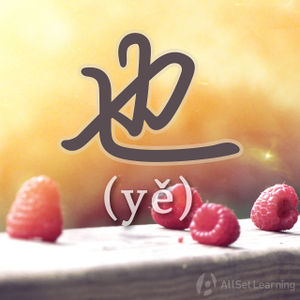The "also" adverb "ye"
-
Level
-
Similar to
-
Used for
-
Keywords
The English adverb "too" or "also" is expressed in Chinese as 也 (yě).
Contents
也 with Verb Phrases
Structure
Since it is an adverb, "也" is inserted after the subject, before the verb or auxiliary verb:
Subject + 也 + [Verb Phrase]
Please note that in English, we replace the word "too" with "either" in negative sentences. For example:
- A: I like cats.
B: I like cats too. - A: I don't like cats.
B: I don't like cats either.
In Chinese, regardless of whether the sentence is positive ("I like them too") or negative ("I don't like them either"), 也 is used the same way. Just make sure you put the 也 before the 不 (or other negative part that comes before the verb).
Examples
- 我 也 喜欢。I like it too. / I also like it.
- 我 也 有 一个 儿子 。 I also have a son.
- 他们 也 是 法国 人 。They are also French.
- 我 也 在 学 中文。I am also studying Chinese.
- 你 是 北京 人?我 也 是。Are you a Beijinger? I am too.
- 他 也 不 知道 这 是 什么 。I don't know what this is either.
- 我 知道 你 也 想 去 。I know that you also want to go.
- 我 也 喜欢 吃 水饺。I also like to eat boiled dumplings.
- 你 也 喜欢 喝 啤酒 吗?Do you like to drink beer, too?
- 你 也 会 来 我 家 吗?Will you also come to my home?
- 你 也 觉得 这 个 餐厅 不 好?You also think that this restaurant isn't good?
也 with Adjectives
Structure
也 can also be used with adjectives. 你知道在汉语中如果是形容词直接做谓语,那么这个形容词前面一般要用一个副词修饰,尤其是单音节形容词。所以在这里,形容词前面要加一个副词,比如"很""比较""挺""非常"。如果不是特别强调,一般人会忽略"很"所包含的very的意思,只用于补足音节、修饰句子。
Subject + 也 + Adverb + Adjective
Examples
- 你 也 很 高。You are also tall.
- 他 也 很 胖。He is also fat.
- 昨天 很 冷,今天 也 很 冷。Yesterday was very cold, and today is also very cold.
- 这 种 酒 也 很 好 喝。This kind of alcohol is also very good.
- 他 生气 了?我 也 很 生气!He got angry? I'm also very angry!
- 这 个 问题 也 很 麻烦。This problem is also very troublesome.
- 我 觉得 这 个 餐厅 也 很 好。I think that this restaurant is also good.
Expressing "me too" with 也
It can be tricky to know how to say "me too" when you first study 也, as you can't say "我也......" - this is not a complete sentence; you can't just leave 也 hanging there with nothing after it.
The correct sentence is "我也是," which literally means, "I am too," but can also stand in for "me too."
Structure
The correct structure uses the verb 是:
- * 我 也 是。(The 是 fills in for whatever was just said.)I am too. / Me too.
- * 我 也 。 (Always put something after 也! It never ends a sentence.)
Examples
The "me too" structure works with other subjects, as well.
- 他 也 是 。 He is too. / Him too.
- 我们 也 是 。 We are too. / Us too.
- 我 太太 也 是 。 My wife is too. / My wife too.
- 我们 公司 也 是 。 Our company is too. / Our company too.
- 中国 人 也 是 。 Chinese people are too. / Chinese people too.
- 巧克力 也 是 。 Chocolate is too. / Chocolate too.
- 冰 的 可乐 好喝,咖啡 也 是 。 Cold cola is good. Cold coffee is too.



